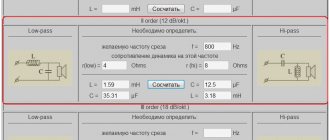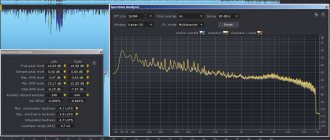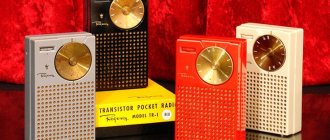Relatively recently, I came across an interesting video from the Gutenberg Smoking Room called “Psychoacoustics: Sound Illusions,” albeit a student one. The video inspired me to rummage through my student notes and materials...
To be honest, I didn’t really like the Audio Coding subject when I was a student at TU Ilmenau in the Communication and Signal Processing program - stress and youthful maximalism were doing their dark work. However, from the outside I more often heard the opposite point of view: “Cool subject, why are you complaining? One of your lecturers is Karlheinz Brandenburg himself - seize the moment!”
One of the main developers of the MP3 format, if you didn't recognize it, is posing with headphones. (image source)
As time passed, I, of course, revised my view on this subject. Knowledge at the intersection of digital signal processing, biology, physics and computer technology - that’s cool! The topic of the already mentioned psychoacoustics alone is worth it.
And then one day another adventurous thought came to my mind, and I said to myself: “Why not write a popular science article about audio coding? So to speak, “for the little ones” - for students like me”?
No sooner said than done.
Anatomy is horribly interesting
Before we talk about how exactly a person perceives sound, and what mathematical models can be used for this, let’s talk about the main thing: what allows a person to perceive sound in general?
Of course, the auditory system! To be precise, mainly the inner and middle ear and their specific components:
- eardrum (eardrum) : transmits air vibrations (sound waves) to the auditory ossicles in the form of vibrations;
- auditory bones of the middle ear (ossicular bones) : hammer, incus, stirrup - transmit mechanical vibrations to the cochlea;
- cochlear structure : induces traveling waves along the length of the basilar membrane;
- neural receptors : convert vibrations into chemical and electrical signals (have connections along the entire length of the basilar membrane).
Rice. 2. The internal structure of the human ear.
Everything seems to be intuitive, provided that you have some school knowledge. The difficulty is usually only caused by the cochlea: what does this abstruse phrase mean: “induces traveling waves along the length of the basilar membrane”?
Paradoxical as it may seem, everything here is also quite simple. First, let’s list what the cochlea consists of:
- There are fluids inside the cochlea: perilymph and endolymph;
- there is also a basilar (basal, main) membrane inside;
- Hair cells (part of the organ of Corti) are attached to the basilar membrane.
The eardrum transmits sound vibrations to the bones of the middle ear; the ossicles of the middle ear transmit vibrations to the pereimph and endolymph; under the influence of vibrations of the perilymph and endolymph, the basilar membrane also vibrates; Due to the movements of the basilar membrane, hair cells produce signals that are transmitted to nerve cells.
I suggest you read more here and here.
Rice. 3. The internal structure of the human ear: the basilar membrane in an “unfolded” form (link to the source of the illustration).
Due to the shape of the basilar membrane (tapering towards the base) and the fact that cells responsible for the perception of different frequencies are connected to different parts of this membrane, the cochlea is a nonlinear system with frequency selectivity.
What if you look at the cochlea through the eyes of digital signal processing?
From a DSP point of view, the cochlea is a bank of bandpass filters. In this case, the filters overlap each other greatly.
Rice. 4. Tone responses in different places of the basilar membrane [1, p. 63].
What is shown in the picture:
- A tone with a duration of 1 ms, and therefore a frequency of 1 kHz (time function indicated on the top plate) produces responses at five different locations on the basilar membrane (five functions below, depicted opposite specific locations on the membrane).
- The maximum response corresponds to the middle of the membrane - where it responds to frequencies of 1 kHz (logical).
- The minimum responses are at the edges of the membrane (x4, x2, x1 indicate how much the graphs have been enlarged for illustration).
Kind people have already drawn useful structural diagrams:
Rice. 5. Part of the perceptual model diagram (see PEMO Model) concerning the basilar membrane.
The overlapping filters are shown, in my opinion, very clearly.
At some point, they decided to somehow put the knowledge about the cochlea as a bank of filters into a simple and accessible model. During a series of classroom experiments [1, p.82-85], scientists determined that:
- the frequency groups into which the basilar membrane divides the audio signal have a fixed bandwidth;
- The bandwidth of a frequency group depends nonlinearly .
Moreover, for convenience, we agreed to assume that the filters of our auditory system are rectangular.
All of the above was ultimately generalized into the concept of the Barkov scale - a scale of critical frequency ranges (see RWTHxCA101 - Critical bands), the width of which nonlinearly depends on the average frequency:
Rice. 6. Barkov scale ().
Let's remember this fact, it will be useful to us later.
I couldn't help but share!
While I was looking for illustrations on the Barkov scale I came across this image:
bark scale by spooninglive
Bark!
Okay, now we have a little better idea of what kind of system allows us to hear. Moreover, we found that the hearing organs are a nonlinear frequency-selective system. We even found out how its selectivity works in terms of the width of the critical ranges.
But we have not yet said whether we hear certain frequencies equally. Perhaps there are some suitable experiments?
Useful reading. 10 books from musician and sound researcher Stas Sharifullin
In the “Useful Reading” section, we ask experts in the field of education, friends of the “Workshop” and famous people to tell us about non-fiction books that helped them in their careers, self-development and self-education. In the new selection, Stas Sharifullin, co-founder of the Klammklang label and head of the new master’s degree in Sound Art & Sound Studies at the HSE School of Design, shares his list of favorite and useful literature.
This is a selection of books about how to learn to listen to the world around us. For some, these books can become a guide to action - and this is wonderful, because sound practices are more accessible today than ever before; besides, we are all musicians, we just don’t want to admit it for some reason. Others will hopefully find these books helpful tips on how listening practices can help them find peace in these troubling times.
"The Book of Sound. A Scientific Odyssey into an Acoustic Wonderland by Trevor Cox
No one writes about the nature of sound with more excitement and enthusiasm than Trevor Cox. This is a book about singing sands and spy listening stations, about burial chambers and barking fish, about whale migration and shipping. Using such non-trivial examples, Cox, a practicing acoustic engineer, explains in simple terms how sound behaves in different spaces and, for example, talks about noise pollution. An excellent book for immersing yourself in the topic.
"Sound. A Very Short Introduction by Mike Goldsmith
A scientific basis for those who want to dig deeper. Mike Goldsmith graduated from the Department of Physical and Applied Acoustics and even headed the UK National Physical Laboratory for some time, after which he decided to become a popularizer of science. His book, part of a well-known series, is a brief and accessible introduction to the physics of vibrations and waves, acoustics, psychoacoustics and the physiology of hearing. In addition, Goldsmith describes the basics of working with studio and recording equipment, and also makes appropriate references to the work of famous cultural theorists, such as Roland Barthes.
Conversations with Cage, Richard Kostelanetz
John Cage not only taught the whole world to listen to silence, but also told us why all the sounds that sound in this silence can be considered music. Richard Kostelanetz collected interviews with Cage over the years, cut them into parts and combined them into different thematic blocks. The result is something like an autobiography, in which the master talks about different stages of creativity, his work with various types of art and much more - for example, about picking mushrooms. This book for me is first and foremost a collection of ideas: Cage was the main modern artist who worked with sound in the last century, and we still have a lot to learn from him.
Silence is a change in my consciousness. It's about accepting the sound that already exists, rather than wanting to choose and impose your own music. Since I realized this, silence has been central to my work. When I compose music, I try to do it in a way that doesn't disturb the silence that already exists.
— Richard Kostelanetz
"Noise. The Political Economy of Music, Jacques Attali
To talk about the big ideas of past years that have not lost their relevance: in 1977, the French economist and political scientist, future adviser to the country's president, Jacques Attali, wrote a book about how, by studying musical culture, one can identify the basic principles of the functioning of society in a certain era, and even predict important changes that may occur in the future. The predictive potential is most impressive. For example, there are thoughts here that the technological leap in the field of sound recording media will soon lead to the fact that music will turn into a mass-produced commodity, will become free or very cheap and, as a result, will lose its political potential. Quite an accurate description of streaming thirty years before its introduction, isn't it? And this is just one of many ideas.
"Sound (Documents of Contemporary Art)", edited by Caleb Kelly
A small but informative anthology for those who want to understand the relationship between sound and contemporary art. Many texts from different years are collected here - from early futurist manifestos to excerpts from the works of modern theorists. If you pick up this book, pay attention to the section devoted to our topic - listening. There's an essay by sound art pioneer Alvin Lussier whose title, I think, should become a new rule for everyone doing all these endless online broadcasts today: "It's more important to listen carefully than to make sounds." As I type these lines, I listen to the birds singing outside the window - and it seems that this is the best music I heard during self-isolation.
"Sonic Meditations" by Pauline Oliveros
Let's move from theory to practice. If Attali writes that we all just have to become “composers of our own listening,” then for Pauline Oliveros we are all already composers and musicians from birth. Like previous authors, we just have to learn to listen, and for these purposes, one of the key representatives of the American avant-garde scene offers her “Strategies for Attention” - a collection of poetically designed exercises in musical improvisation and meditation, most of which do not require any special instruments or skills. Some of them seem perfect for lockdown: “Go for a walk at night. Walk so quietly that the soles of your feet become your ears.”
"A Sound Education: 100 Exercises in Listening and Sound-Making" by Raymond Murray Shafer
Another collection of exercises for training a conscious attitude towards sounds. Canadian composer and sound researcher Raymond Murray Shafer was among those who first tried to draw humanity's attention to the problems of sound ecology associated with the growing level of anthropogenic noise. Previously, with shining eyes, he prepared resolutions for UNESCO, but today he has retired to a forest hut, from where he sometimes sends his laconic calls to finally shut up and listen to the world around us.
"The Great Animal Orchestra", Bernie Crouse
A book about a great love for animals and the sounds they make, and also a good workshop for those who want to learn by heart all the existing onomatopoeic words in the English language. For Bernie Crouse, all the animals on the planet are a huge orchestra that we must learn to listen to in all its diversity while we still have the opportunity. This is the main idea of the author, who has devoted almost his entire life to field recordings of animal voices: the soundscape is becoming quieter, and we humans are to blame for this. Essentially, this is a continuation of Shafer’s ideas, and as in the previous case, for the full effect of Bernie you need not only to read, but also to watch - for example, this TEDx talk broke my heart. Another sad, but very illustrative example of how we can understand the world around us through sound.
Much later, I learned that all living organisms produce unique sounds that are unique to them. For example, when viruses detach from a cell surface, they emit a short sonic pulse—an abrupt and rapid change in amplitude that we can only detect with the most sensitive instruments.
— Bernie Crouse
Specters: Composer l'écoute / Composing listening
A collection of essays exploring various aspects of listening and sound creation. The lyricists and compilers of the collection are well-known experimental musicians of the past and present, whose practice, to one degree or another, goes back to the legacy of the pioneer in the field of sound research Pierre Schaeffer, one of the most important figures of the post-war musical avant-garde. The result is an excellent selection of inspiring texts, most of which can be taken as a guide to action. This, according to the compilers, is the main goal of the book: to remind us that experiment is a method, not an aesthetics, and to invite us on a “journey through uncharted territories.” And it works.
"The Order of Sounds: A Sonorous Archipelago", Francois Bonnet
Finally, I would like to recommend a rather difficult read from François Bonnet, a philosopher, musician, keeper of the archives of Pierre Schaeffer and one of the compilers of the previous collection. This is not only an extremely detailed study of the nature of sound from a philosophical point of view, but also a unique project for the emancipation of hearing, freeing it from the influence of various sociocultural constructs, to which the author includes, for example, music. It is also a reminder of the all-pervasive nature of sound: it was, is and will appear regardless of whether we want it or not.
Threshold in silence
Of course, there are such experiments. Moreover, such experiments have been carried out for a long time. For example, Eberhard Zwicker describes one of them as follows [1, p. 63]:
The subject, registering the hearing threshold, is tasked with changing the sound pressure level using a switch so that the moments of barely noticeable appearance and disappearance of sound are noted with confidence. In this case, the recorder pen crosses out a zigzag stripe on the paper, consisting of vertical strokes, within which there will be those pressure values for which it is not certain whether a sound was heard or not.
Ultimately, we collected 100 such measurements from people of both sexes aged 20-25 years and calculated the average values.
Rice. 7. Averaged hearing threshold curves for young subjects with healthy hearing. [1, p. 64]
And then the median (the curve between 10% and 90% in Fig. 7) was called the hearing threshold (or “ threshold in silence ”) and was included in the standards (including our GOST).
Rice. 8. Threshold in quiet, hearing threshold, risk of damage, threshold of pain (source). Yes, pain does not warn of danger, but simply states the fact of a negative impact on hearing.
There is even a special formula for this:
where is, as you might guess, the frequency in kilohertz.
Let's talk about the essence of the threshold of audibility once again: in order for any sound to be heard, it must exceed the value of the “threshold in silence.” That is, evolution has arranged everything in such a way that we are almost guaranteed to hear sounds near 2-4 kHz, however, we are almost as guaranteed not to hear too low and too high frequencies.
Do you remember ultrasound on phones?
The threshold in silence in the form in which it is presented in Figure 5 is, as a rule, relevant for the average group of young people. With age, the perception of high frequencies changes:
At one time, this fact, as far as I know, became the basis for replicating the ultrasonic telephone ringing signal among teenagers: it was assumed that adults (for example, teachers) would not hear it, and therefore would not become irritated by extraneous noise. Well, in the years of my youth, this idea brought nothing but “torture” of classmates with an annoying and intrusive sound in the middle of the lesson by a bunch of “passionaries”...
Why is the phrase “in silence” applied to this curve?
Because it is assumed that this is how people perceive sound in the absence of extraneous noise. When noise appears, the threshold will, as it were, “rise.” In the case of broadband noise, the picture will look like this:
Rice. 8. Levels of masking thresholds (the term will be discussed below) with white noise depending on the frequency of the test tone. The dotted line marks the slope of the curves at high frequencies. [2, p. 62]
What about narrowband noise?
I. Aldoshina – Lectures on psychoacoustics
Part 1. Fundamentals of psychoacoustics (archive of the magazine "Sound Engineer": 1999: No. 6) Part 2 Nonlinear properties of hearing (archive of the magazine "Sound Engineer": 1999: No. 7) Part 3 Auditory analysis of consonances and dissonances (archive of the magazine "Sound Engineer": 1999: No. 9) Part 4 Binaural hearing and spatial localization (archive of the magazine "Sound Engineer": 1999: No. 10) Part 5 Binaural hearing (continued) (archive of the magazine "Sound Engineer": 2000: No. 1) Part 6 Auditory masking part 1 (archive of the magazine " Sound engineer": 2000: №2) Part 7 Auditory masking part 2. Binaural masking (archive of the magazine "Sound engineer": 2000: №3) Part 8 Auditory thresholds, part 1 (archive of the magazine "Sound engineer": 2000: №4) Part 9 Auditory thresholds, part 2 (archive of the magazine "Sound Engineer": 2000: No. 6) Part 10 Auralization - virtual sound world (archive of the magazine "Sound Engineer": 2000: No. 7) Part 11 Loudness, part 1 (archive of the magazine "Sound Engineer": 2000 : No. 8) Part 12 Volume of complex sounds, part 2 (archive of the magazine “Sound Engineer”: 2000: No. 9) Part 13.1 Subjective criteria for assessing the acoustics of premises. Part 1 (archive of the magazine “Sound Engineer”: 2000: No. 10) Part 13.2 Subjective criteria for assessing the acoustics of premises, part 2 (archive of the magazine "Sound Engineer": 2001: No. 1) Part 14.1 Timbre, part 1 (archive of the magazine "Sound Engineer": 2001: No. 2) Part 14.2 Timbre, part 2 (archive of the magazine "Sound Engineer": 2001: №3)
Part 14.3 Timbre, part 3 (archive of the magazine "Sound Engineer": 2001: No. 4) Part 15.1 Auditory perception of spatial systems, part 1 (archive of the magazine "Sound Engineer": 2001: No. 8) Part 15.2 Auditory perception of spatial systems, part 2 (archive magazine "Sound Engineer": 2001: No. 9) Part 16 Interaction of acoustic systems and premises - stereophonic past and multi-channel future (archive of the magazine "Sound Engineer": 2001: No. 10) Part 17.1 Hearing and speech, part 1 (archive of the magazine "Sound Engineer": 2002: No. 1) Part 17.2 Hearing and speech, part 2 (archive of the magazine "Sound Engineer": 2002: No. 3) Part 17.3 Hearing and speech, part 3 Acoustic characteristics of speech (archive of the magazine "Sound Engineer": 2002: No. 4) Part 17.4 Hearing and speech, part 4 Subjective and objective methods for assessing speech intelligibility (archive of the magazine "Sound Engineer": 2002: No. 5) Part 17.5.1 Hearing and speech, part 5.1 Acoustic characteristics of vocal speech (archive of the magazine "Sound Engineer": 2002: No. 9 ) Part 17.5.2 Hearing and speech, part 5.2 Acoustic characteristics of vocal speech (archive of the magazine “Sound Engineer”: 2002: No. 10)
https://cloud.mail.ru/public/BXHe/ENPrbkvSW
Post Views: 1,458











